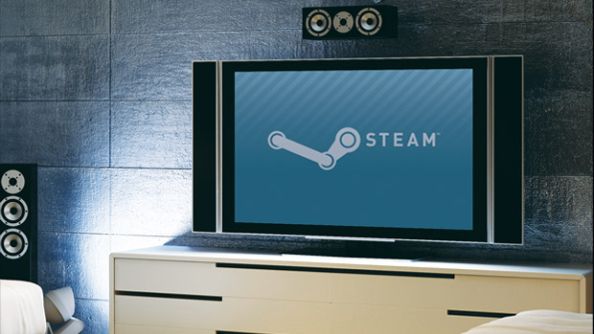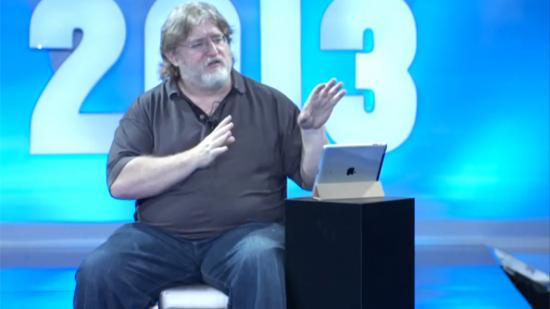Last night, Valve’s co-founder and MD Gabe Newell took to the stage at the 2013 DICE summit to explain some of the thinking between Valve’s eye-catching announcements and initiatives. In a thirty minute talk titled “A View on Next Steps”, he covered Valve’s hardware plans, the growing Steam economy, and why Valve are working on Linux. Much of what he says would feel like sci-fi five years ago. Here’s what we learned.
1. Valve’s living room PC will come in many flavours, including a device that streams your games across your home network.
Gabe was impressed by the device manufacturers at this years Comsumer Electronics Show who were showing small streaming devices that could plug into the back of your television and display the content on your living room PC. “Latency was basically non-existent,” he said.
2. This is different from cloud gaming, which isn’t suitable for our favourite games.
Gabe has long been a critic of games that stream their content from servers online, rather than do their computing locally. He outlined why: it’s a question of latency. “The ability to do local high-speed processing will become more than it is right now,” said Newell. “We actually think there’s going to be hardware in the future that has more sensitivity to latency than a human does.”
I think he’s probably referring here to some of the VR and wearable computing concepts that Valve have said their working on. Latency is a real issue that the VR manufacturers face – if it’s not reduced to the barest minimum it’s almost guaranteed to cause nausea.
3. Linux is PC gaming’s “get out of jail free card.”
Gabe’s been outspoken about Microsoft and Windows 8 and in response, has rapidly increased its support for Linux. In my view, the most important step is to now help the rest of the industry produce high quality Linux games, either emulated in WINE or native ports. Linux is something “we’re going to continue to focus on and help partners on,” says Gabe.
4. Valve are thinking very hard about how items and valuables move between games.
Currently, the Steam Marketplace acts as an auction house for items earned in-game. Currently, the central currency is cash and items are one game, one use. But the data Valve are gathering around their free-to-play experiments suggest that a central economy that allows goods and services to be transferred in and out of games is on the cards.
He pointed to a liquidity crisis in Team Fortress 2, where earbuds, an item given to players who tested TF2 on the Mac, were used as a currency (due to their being a fixed number of buds in the system). Rather than exchange buds, players began to hoard them.
The solution: a comparison with MMO games.
“In MMOs, it’s saying that all games are going to turn into instanced dungeons of a central economy,” says Gabe. “Everything you do is valuable to other people in that economy.”

5. Not all controllers are equal, but all are worth considering.
PC’s have an advantage in that we can adopt whatever control method we see fit: and pick the best tool for the job. We have mouse and keyboard, joysticks, joypads, trackpads. Now, we’re facing a future with dedicated motion controls, VR headsets and multitouch displays. “If you have all of those things, how do you segment what thngs are good, and what are stronger at others?”
I do wonder if the next step in Big Picture will be to integrate a touch screen mode. The latest ultrabook spec from Intel demands that laptops include a multitouch display – and the cost of multitouch is rapidly decreasing.
6. Entertainment is fundamentally valuable: Valve want to find ways to help entertaining players fund what they do.
Valve are looking for ways for gamers, press and the community to support themselves. The first steps on this journey were the pennants and team couriers for Dota 2. Finding a way for players to be entertaining, beyond simply showing ads in front of their content, is something that will be core to Steam going forward.
7. The Steam store is boring. This is a problem.
“If you look at the Steam store,” says Gabe, “it’s a very boring entertainment experience. Nobody says, ‘Oh, I’m going to go play the Steam store now.’” Changing that means letting the community build their own storefronts, allowing them to create more entertaining experiences.
8. Valve need to get out of the way.
The money quote: “this notion that someone is acting as a global gatekeeper is really a pre-internet way of thinking about that.”
9. Console transitions are “disruptive”.
Gabe understands and is keen to point out that Steam and Valve’s success was delivered on the back of open platforms. “Our company wouldn’t exist if it weren’t for the openness of the PC.” But there’s something else about the PC that’s worth understanding: it lets you build and improve over decades. Steam launched nearly 10 years ago; it’s the result of nearly a decade of super-smart people working with and listening to their community.
Console transitions are dangerous. “They’re an outdated way of progressing,” says Gabe, “as they cause developers’ work to become redundant over time.”
